Archived Article Detail
By Thomas P. Moore
Need to search for a keyword, title or article on this page? On your keyboard, hold down the “Ctrl” and “F” key and a “Find in page” box will appear at the bottom of your screen. Type in your keyword and check the “Highlight All” box and like magic your keyword will appear highlighted as you scroll up and down the page!
WHAT’S NEW IN THE MINERAL WORLD ARCHIVE – posted on 4/16/2010
April 27, 2010
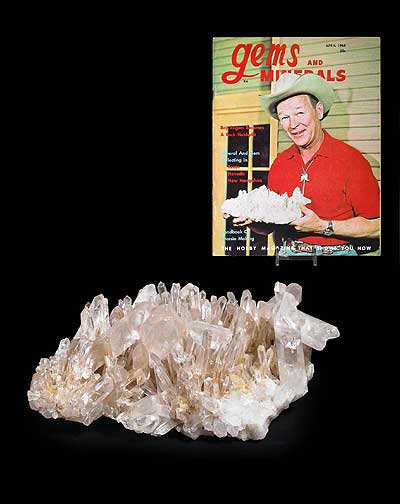
Another blog-like update today, to inform all you old media-cowboy fans (Baby Boomers take special note) about an upcoming auction of the Roy Rogers mineral collection in New York on May 27, with a preview in Los Angeles on May 6 and 7. The auction house is Bonhams & Butterfields (www.bonhams.com/us), which recently has obtained this collection from the former Roy Rogers-Dale Evans Museum. For many years the Museum was sited just across the street from Roy’s own Apple Valley Inn in Victorville, California, attacting visitors with its displays of Rogers/Evans movie memorabilia, including costumes worn in their movies, Roy’s gun collection and hunting tropies, saddles and gear, and even the famous (stuffed and mounted) horse Trigger. Roy’s personal mineral collection, his lapidary equipment, and some of his home-made jewelry were also on display. Roy died in 1998 and the Museum moved to Branson, Missouri in 2003; it closed its doors there at last on December 12, 2009. Lots from the mineralogical holdings of the King of the Cowboys will be auctioned “without reserve” as part of a larger Natural History auction at Bonhams & Butterfields headquarters, New York, on May 27, with a west-coast preview very soon now– at Bonhams & Butterfields, Los Angeles (7601 W. Sunset Boulevard) on May 6-7.
The cowboy actor/singer was born Leonard Franklin Slye in Cincinnati, Ohio in 1911. After a difficult childhood and youth during the early part of the Great Depression, he formed a singing group called “The Sons of the Pioneers,” which recorded its first hit song in 1934. For a few years, still as Leonard Slye, he took small parts in Western movies, not becoming “Roy Rogers” until 1938, when he was brought in as a replacement for Gene Autry in a movie contract. In 1947 he married Dale Evans, and the couple went on (as they say) to stardom. By that time a resident of California, Roy got interested in mineral collecting around 1968, and acquired specimens as much through field collecting out in the desert as through the “silver pick.” He enjoyed lapidary work too, but relished his crystal specimens most of all: he appeared on the cover of the April 1968 Gems & Minerals, with his large (Arkansas?) quartz crystal cluster—see photo above. For more on Roy Rogers, see the entry in our Bibliographical Archive, www.MineralogicalRecord.com/labels.asp?colid=1076.
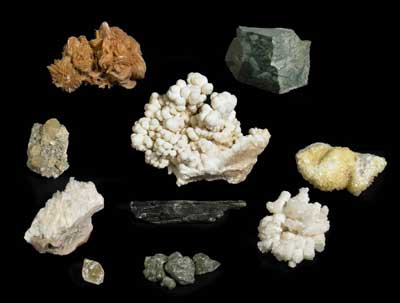
As the photo above implies, Roy Rogers’ minerals probably are not, for the most part, of sophisticated, “competitive” kinds—but many were dug by Roy personally, and will surely make good display items for that reason alone. Lapidary creations crafted by Roy, such as the fire agate ring shown below, and such things as petrified wood, agate and jasper specimens, as well as Native American arrowheads and hand tools, and the quartz specimen from the Gems & Minerals cover, all likewise passed through Roy’s hands or were actually fashioned by them. It should be an interesting auction…and if you want to make it to the “preview” in Los Angeles on May 6-7 you would do well to plan your excursion now.
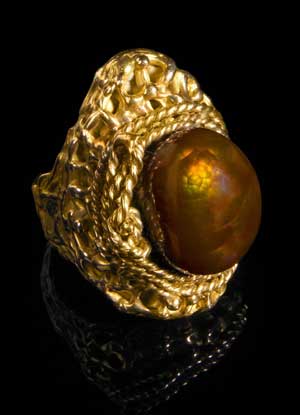
April 17, 2010
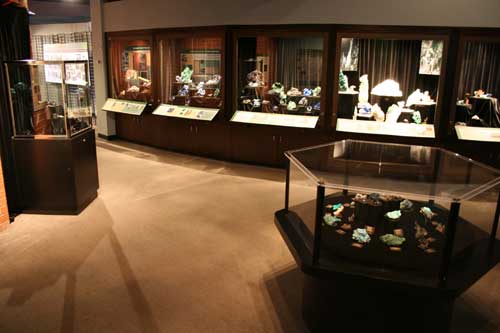
Today I am posting a blog-like update to the March 19 what’s-new web survey and its March 23 addendum, below. It’s too early to archive the survey and replace it with a new one, but I need to post this update right now in order to tell you about a wonderful exhibit in Tucson which will close at the end of May 2010. The exhibit, “Treasures of the Queen,” is devoted to the minerals, and to the history, of the famous copper-mining district of Bisbee, Arizona. You will find “Treasures of the Queen” spread out enticingly along an alcove winding off just to your right as you come in the main entrance to the University of Arizona’s Science Museum, in the Flandrau Planetarium building on the main University of Arizona campus.
The funding for “Treasures…” was kindly provided by the Freeport-McMoRan (formerly Phelps-Dodge) Corporation; Freeport-McMoRan also provided some of their important Bisbee specimens, some of which have not been publicly displayed for a century. Responsibility for the exhibit’s organization was assumed by the University of Arizona Mineral Museum and Flandrau Science Center: Dr. Bob Downs, Professor of Mineralogy and Crystallography and head of the Ruff project at Geosciences, is the Head Curator of the U. of A.’s Mineral Museum. For the stunningly effective mounting of the exhibit, major credit goes to the staff of Flandrau and to the enthusiastic new Assistant Curator, Mark Candee, former president of the Tucson Gem & Mineral Society. For lending the fabulous Bisbee specimens which are (of course) the exhibit’s stars, and for many other forms of assistance, twenty people and seven institutions are credited; these include Richard W. Graeme III and his sons, Richard IV and Doug Graeme, Evan Jones, Les and Paula Presmyk, Bill Larson, Gene Schlepp, Marcus Origlieri, the Arizona Historical Society, the Arizona-Sonora Desert Museum, and the Bisbee Mining and Historical Museum. The names of these and other generous enablers are duly displayed on one of many wall placards along the alcove. Other placards—richly detailed, well designed and professional-looking—have texts supplemented by greatly enlarged, old-timery photos from 100 or more years ago, recounting, among other things, the history of Bisbee; the life of George Warren, discoverer of the great copper deposit (you’ve seen the famous shot of him, leaning melodramatically on his prospector’s shovel), the women of Bisbee (one wall case displays a wedding gown from 1881), and a list of Bisbee’s 323 known mineral species. A one-ton ore car from Bisbee rests at the end of the alcove, and a running video put together by Shipherd Reed, of Miner’s Story Project, provides voice-over commentary nonstop. The lighting along the alcove is reverently dim but the lighting inside the cases is bright; the specimens rest dramatically on folds of black velvet spread over cut-to-size pedestals. All in all the physical layout, supportive material, and general ambiance are excellent without being pretentious—directing the viewer’s main attention to where it belongs, i.e. onto the gorgeous Bisbee specimens in the cases.
The sub-themes of the cases set into the walls are copper; malachite and azurite; azurite and malachite; carbonates from the caves in and around the Bisbee orebodies; minerals of the Campbell Shaft; and specimens from the “Columbia Pocket” (a 60-foot cavity on the Czar mine’s 200 level which furnished these boulder-size dazzlers, which were shown at the 1893 Columbian Exposition in Chicago). And then there are the two floor cases, one for Bisbee cuprite and one for a selection of very rare Bisbee species. Among the rarities are connellite, digenite, covellite, paratacamite, spangolite, graemite, chalcoalumite, dioptase, a hemimorphite which could easily have come from Mexico’s Ojuela mine, and Evan Jones’ superb, unique thumbnail of paramelaconite (obtained by Evan recently from the former Minette collection). The cuprite case contains just nine specimens, of which three are thumbnails—but what cuprites these are! One indeed is probably the finest cuprite specimen in the world: a blood-red, totally gemmy, cubic crystal 2.6 on edge on microcrystallized antlerite, perfectly backlit, in the exhibit, such that its fiery beauty compels attention from several feet away. (This specimen was collected in August 1986 by Richard Graeme III and his two sons; it is pictured in my article on the Graemes in March-April 2006, and on the cover of the May-June 1987 issue.)
Not only lovers of Bisbee minerals, but all serious mineral collectors, should see this exhibit. And bring the kids: I heard one little boy, gazing raptly into one of the cases, inquire of his father “do you mean that all this is rocks that came from the ground?”
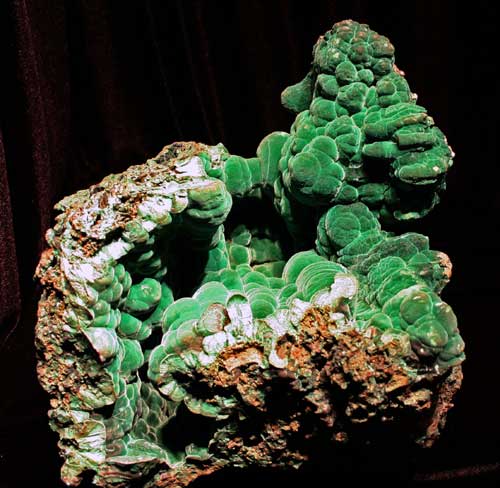
Queen mine in the late 1800s; shown at the Columbian Exposition
(Chicago World’s Fair) of 1893. Freeport-McMoRan Corp. specimen;
Shipherd Reed photo.
March 23, 2010
This is a (gulp!) ERRATA note with reference to the report (below) posted four days ago. First, I was wrong to say that Dave Waisman’s upcoming San Francisco Show will be the first show in that city which Dave has mounted. In fact, the first was held last year (I forgot about it because I didn’t attend it). The show to be held in San Francisco on July 9-11 is actually the second installment of what we hope will be a reliable yearly event.
Also, in telling you about the new specimens of owyheeite, purportedly from the Fuwang silver deposit, Gaoyao County, Zhaoqing Prefecture, Guangdong Province, China, I expressed some doubt both about the locality and about the species identity of the specimens of a metallic mineral, in “nests” of steel-gray acicular crystals over crystallized sulfides, now being offered on the website of the new Chinese dealership Jin-ming mineral(see paragraph and picture below). Jean-Francois Carpentier has written to inform me that these specimens have been verified as owyheeite by SEM-EDX and two single-crystal x-ray diffraction experiments—see www.mindat.org/photo-254736.html. These would thus seem indeed to be among the world’s best specimens of the rare sulfosalt owyheeite so far found anywhere. The locality, however, may still be thought somewhat questionable. At first, M. Carpentier says, the specimens were said to be from the famous Yaogangxian mine, Hunan Province—in effect a “default” locality for many similar-looking acicular sulfosalts from China. But the Fuwang deposit, though too newly developed to have been mentioned in either Guanghua Liu’s or Berthold Ottens’ books on Chinese mineral localities, is nevertheless a real locality, and is a better bet to be the true source of the new specimens of owyheeite: a species not heretofore noted as occurring at Yaogangxian.
You may now read on…
March 19, 2010
The 2010 Tucson Show is a month behind us, and you will see the show report in the May-June 2010 issue. Meanwhile, here in cyberspace, quite a few dealers are marketing their Tucson Show acquisitions (as well as other tempting items), and so the report below presents a few nice things which may be looked up on the web. Welcome to the spring shopping season…
What’s New Online
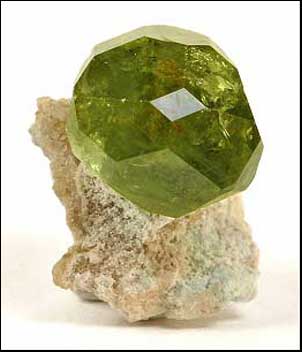
Antsiranana, Madagascar. Arkenstone specimen; Joe Budd photo.
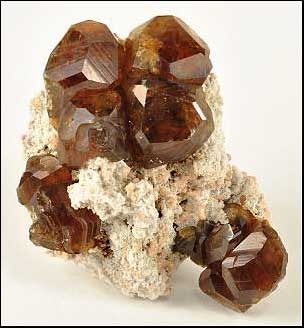
Antsiranana, Madagascar. Arkenstone specimen; Joe Budd photo.
The 2009 Denver Show saw the market debut of lovely specimens of andradite variety “demantoid” and variety “topazolite” from diggings in a muddy mangrove swamp near the village of Antetezambato, on the northern coast of Madagascar. The specimens kept on coming for Munich 2009 and Tucson 2010, and those who want to learn about the occurrence can look forward to a full article by Federico Pezzotta which will appear in our May-June issue. Even though they are not exactly breaking news by this time, these green and brown natural jewels are still so newsworthy that I must direct your attention to the 46 top-quality specimens which Rob Lavinsky has scored and which he is now marketing on his The Arkenstone site (www.irocks.com). The andradite crystals are face-rich but dominated in most cases by the dodecahedron, and they reach 3 cm. Their colors range from a rich grass-green (“demantoid) through greenish brown, yellowish brown and medium brown (“topazolite”), and most of the crystals are gemmy and highly lustrous as well. Matrix specimens show individual crystals or congregations of crystals resting on pale yellow limestone or massive andradite, and the matrix pieces cover the full size range from thumbnail to medium-cabinet. Here, from Rob’s site, are pictured a thumbnail (already sold) of demantoid and a large miniature of topazolite…just to demonstrate why you should know about this major find of gem-quality garnets.
In these online reports (as well as in print reports) I have written often of Rob Lavinsky’s offerings, and that is because he routinely has new things most worthy of our attentions, including one-of-a-kinders from isolated finds and from old collections. As an example of one-of-a-kind surprises such as may await the visitor to Rob’s The Arkenstone site, here is something from his latest posting that has been haunting my dreams: a loose, 1.8-cm crystal of native tellurium from the Emperor mine, on Viti Levu Island, Fiji, in the South Pacific. As the article in July-August 2008 can tell you, the Emperor gold mine, inaugurated in 1935, continues to this day to provide major income for the Republic of the Fiji Islands (independent from Great Britain since 1970), and is the source of the world’s finest specimens of sylvanite and of metallic tellurium; Fijian crystals of the latter species reach 4 cm exceptionally. Rob has already sold (for $2000) the crystal shown here, but others like it may show up occasionally—native element-fanciers take careful note.
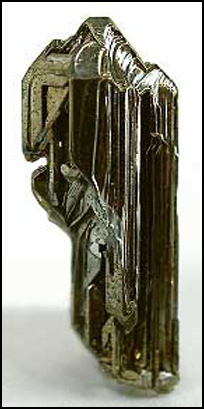
Arkenstone specimen; Joe Budd photo.
From Rob’s site, too, I show a Joe Budd photo of a fine specimen from the fall 2009 discovery of mimetite in the centuries-old Haus Baden mine, Badenweiler, Baden-Wü, Germany. Abundant specimens of this pretty yellow-orange mimetite, showing rich coatings of globular forms on matrix pieces to large-cabinet size, were on hand at the 2009 Munich show, and I described them in my Munich report in January-February 2010, but we didn’t have a good picture to run at the time. So here is what they look like—“revived” examples of an old classic German occurrence, offered at prices which so far have been in the HQLP (“high-quality-low-price”) range, i.e. under $200 for an excellent miniature-size example. Right now a few specimens of the new Badenweiler mimetite are being offered on the site of the Polish research group and dealership Spirifer Minerals (www.spiriferminerals.com).
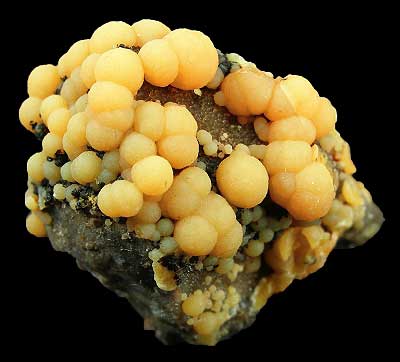
Germany. Arkenstone specimen; Joe Budd photo.
While you are visiting Spirifer, notice, too, the several spectacular cabinet-size crystal groups of gypsum from the Lubin mines, Lubin, Lower Silesia, Poland. “Mines” because there are three mines, interconnected underground, called the Lubin, Polkowice and Rudna mines, and today this complex is one of the world’s largest producers of economic silver and copper. Mining exploits a 60 cm-thick layer of black shale highly enriched in Cu, Ag and Au, above and below which lie halite/gypsum evaporite beds; the ore sulfides are not found as crystals, but gypsum (and marcasite) is taken out as fine crystal groups from rare cavities on the margins of the shale beds.
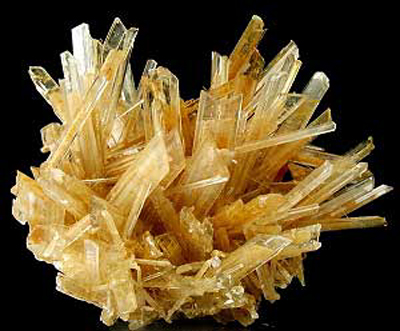
Spirifer Minerals specimen and photo.
The website of Khyber Minerals (www.khyberminerals.com) has a generous page devoted solely to minerals from Mozambique acquired by the dealership at the 2010 Tucson Show. Nearly all of the specimens are from the famous rare earths-enriched pegmatites of the Alto Ligonha district, Zambezia Province (see our special Alto Ligonha issue: November-December 2000). Alto Ligonha saw a period of major mining between the 1930s and 1970s, then a period of dormancy during the political unrest which followed the end of Portuguese rule in 1975, and then, since the 1990s, a period of new productivity. So for the past 10 years or so we’ve been pleased to see increasing market supplies of gem silicates from the region, such as beryl and elbaite, and to a lesser degree of oxides such as microlite and columbite-group species. Khyber Minerals now offers Alto Ligonha specimens including sharp red-brown rutile crystal groups of thumbnail and miniature size; gemmy pale yellow spodumene crystals to 8 cm; sceptered and hollow crystals of green and green/pink elbaite; matrix specimens showing dark green, octahedral crystals of fluornatromicrolite to 1 cm; thumbnails of (very rare, very ugly) scandian ixiolite; and some attractive specimens which are parallel groups of gemmy aquamarine beryl crystals, with prominent pyramid faces between the prisms and basal pinacoids (see photo here).
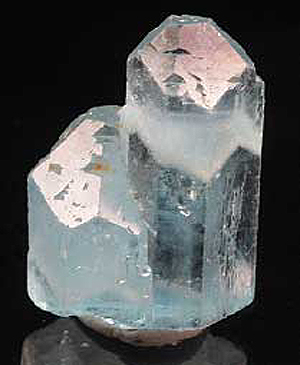
Khyber Minerals specimen and photo.
On John Veevaert’s Trinity Minerals site (www.trinityminerals.com) you will find a cautionary story of specimen-fakery, as well as promising tidings concerning a new skarn locality in Kenya. At the 2007 Tucson Show (John writes), Scott Werschky of Miner’s Lunchbox bought from African gem-seeker and adventurer Campbell Bridges a large lot of material which had been collected somewhere in the Kajiado district, Rift Valley Province, Kenya; the star of the show was grossular, in sharp, partially gemmy, honey-brown to yellow crystals resting in massive blue calcite. Suspecting that some of the specimens were glue jobs, Scott soaked all of them in acetone for several days, and, sure enough, about three-fifths of the matrix pieces had come to market with re-attached crystals. John Veevaert now offers authentic matrix pieces from the other two-fifths of the lot (Campbell Bridges meanwhile having been murdered by bandits in Kenya—see his obituary in March-April 2010). In these pretty specimens, grossular comes as sharp, dodecahedral, pale yellow-brown crystals from 5 mm to 2 cm in massive smoky-blue calcite matrix; in a couple of specimens, crystals of grossular and of the blue calcite rest on blocky white crystals of albite. From the same locality, John also has some miniatures showing rounded, yellow-green, partially gemmy diopside crystals to about 1.5 cm in massive blue calcite, as well as miniature and small cabinet-size matrix pieces with partially gemmy, deep blue, octahedral spinel crystals to around 1 cm in calcite/muscovite or in white marble. We may dare hope that this collecting site will become better known (and better specified) in the future.
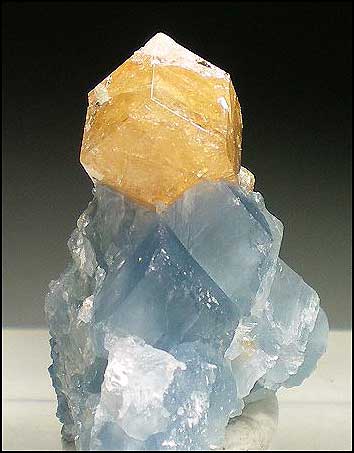
Kenya. Trinity Minerals specimen and photo.
John Veevaert certainly is good at shopping around for his dealership at the Tucson Show—and when he shops with Dudley Blauwet he may (who knows?) find one of the really new things that Dudley has brought back from Pakistan. This time the country of high-mountain pegmatites has, believe it or not, produced wulfenite. The few miniature and small cabinet-size specimens that Dudley scored, and that John is now marketing on his site, come reportedly from somewhere in the Kharan Mountains of Baluchistan, and this is intriguing, since we’ve come to know “Kharan” as the source of world-beating anatase, brookite and axinite-(Fe) which come from Alpine-type clefts. But the new wulfenite specimens feature gossanous matrix spotted with malachite and chrysocolla, bespeaking secondary mineralization in a Cu-Pb orebody. The wulfenite specimens must—so far—be called “modest,” with only sparse coverages of yellow, transparent tabular crystals to 8 mm on matrix chunks…but who knows what is to come? Well, at least Baluchistan is in the southern part of the country, with little Taliban activity to hinder the really important activities, e.g. mineral-seeking.

Trinity Minerals specimen and photo.
Meanwhile, Mike Keim’s Marin Minerals dealership (www.marinmineral.com) now is offering some fine, cabinet-size specimens of anatase from the Kharan Mountains which Mike acquired in Tucson. Matrix plates to 11 cm across are covered with druses of quartz and of water-clear, tabular albite crystals; and then come liberal sprinklings of bipyramidal anatase crystals averaging 1 cm individually. The crystals are both blue and brown, and a few have small gemmy areas. During the past few years we’ve seen plenty of fine small anatase and brookite specimens from Kharan, but big matrix pieces as good as these have been no-shows: who says that anatase is necessarily a “thumbnail species?”
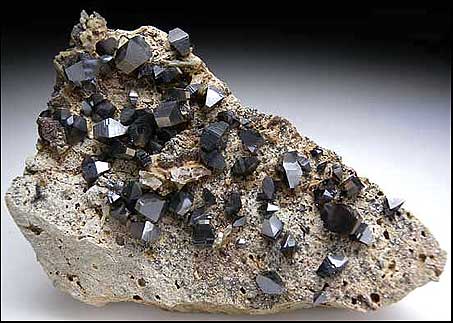
Marin Minerals specimen and photo.
Cyril Kovacic’s Australian CK Minerals site (www.ckminerals.com.au) has a March update well stocked with Australian specimens, mostly one-of-a-kinders, not only from Broken Hill (as you’d expect) but also from other, much less well known localities in the island continent. I recommend in particular some fine siderite, dolomite and calcite specimens from the Mt. Cleveland tin mine, Luina, Tasmania—an underground mine begun during the 1890s, closed, then reopened during the period 1960-1986. The Mt. Cleveland mine calcite specimen pictured here, 24 years old at least, should suggest why some down-under “classic” localities are worthy of our learning much more about them.
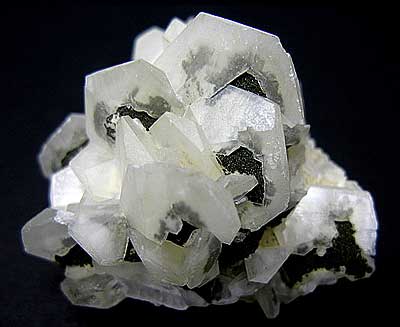
CK Minerals specimen and photo.
Speaking of pretty calcites from little-known places, the site of the British dealership Greenside Minerals (www.greensideminerals.com) is marketing some nice calcite specimens from the Abbeytown quarry, Ballysadare, County Sligo, Ireland. A sizable Mississippi Valley-type stratiform lead-zinc deposit was mined at Ballysadare perhaps as early as the 16th century, giving up few significant mineral specimens before ore mining ceased in 1961; however, the limestone surrounding the orebody has been quarried in later years, and well crystallized calcite is found infrequently in cavities in the limestone. The Greenside Minerals specimens show sharp, clean, milky white calcite crystals to 2 cm on edge, with associations of cream-colored, saddle-shaped dolomite crystals and splotches of galena, pyrite and sphalerite. The specimens now on sale were found in June 2003.
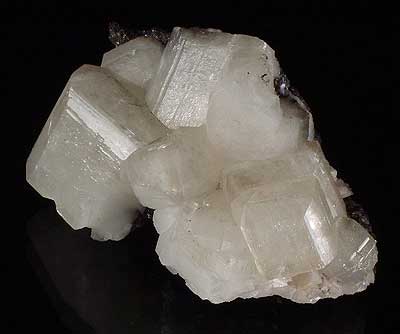
Greenside Minerals specimen and photo.
On his IC Minerals site (www.icminerals.com), Isaias Casanova has three pages of miscellaneous Tucson acquistions, including some specimens of the swanky, gemmy, highly lustrous new purple fluorite from the Ojuela mine, Mexico, and a couple of nice cabinet specimens from a new find of apophyllite-coated quartz crystals from Dalnegorsk, Primorskiy Kraj, Russia. More interesting even than these, I think, are a couple of cabinet-size azurite specimens from the Lost Lake claim, Nacimiento mine, Cuba, New Mexico. According to Isaias, this is an ancient dry lake bed where copper solutions have deposited these earthy bright blue spheres of azurite on a malachite substrate.

IC Minerals specimen and photo.
Italian minerals both “classic” and new like to get together on Alessandro Genazzani’s frequently updated Italian Minerals site (www.ItalianMinerals.com). Noteworthies this time include some excellent miniature and small cabinet-size clusters of green quartz crystals from the island of Elba, and some nice thumbnails and miniatures which are single crystals and parallel crystal clusters of ilvaite from the same place (which is, by the way, the type locality for the species: “Elba” was “Ilva” in Roman days). Typically for the locality, the ilvaite specimens show sharp, black, wedge-terminated crystals, lightly iron-stained (but that’s OK; the brown spots add character). Good ilvaite from Elba, while not in general as pretty and bright as that from Dalnegorsk, Russia, is very elusive on today’s market; specimens come from Ca-Fe silicate skarns which surround the famous hematite/pyrite deposit along the eastern edge of the island.
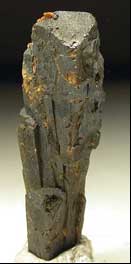
A new Chinese mineral website, that of JinMing-mineral (www.jmineral.com) has made the scene. Text is scarce on the site, but a generous number of pictures show a sprawling shop/showroom full of big carvings and “decorator” pieces, in the city of Guangzhou, Guangdong Province (just north of Hong Kong). The Chinese specimens shown on the site are mostly “standards,” with one intruiging exception—solid coatings of acicular, metallic gray crystals over matrix plates to cabinet size, with small, sharp crystals of pyrite and arsenopyrite discernible in the plates. The acicular metallic crystals are designated as owyheeite: a rare Pb-Ag sulfosalt which is almost unknown in collector-quality specimens from anywhere. The locality for the specimens is given as Changkeng-Fuwang, Gaoyao, Zhaoqing, Guangdong. Well, consulting Berthold Ottens’s recently published, encyclopedic China: Mineralien-Fundstellen-Lagerstä, I find no mention of owyheeite from any Chinese locality, nor, in Ottens’s helpful “Register” of Chinese locality names true and false, anything like the locality stated here. Thus, caution is advised: the species may well turn out to be boulangerite, jamesonite, etc., and the purported locality may be merely “convenient,” as often for new Chinese finds handled by less-than-expert merchants and middlemen. If they are for real, though, these probably are the world’s best specimens of owyheeite—something indeed new and different for your Chinese or sulfosalt suite.

China. JinMing-mineral specimen and photo.
Have you ever derived a kind of long-suffering “fun” from tracking, dealer to dealer and show to show, a wonderful specimen that you would love to own but cannot afford? Such has been my case for several years now with regard to a thumbnail crystal of emerald beryl from Alabashka, Urals, Russia…now being offered for $5500 in Room 1 of Kevin Ward’s Exceptional Minerals site (www.exceptionalminerals.com). For a Russian emerald, this one is amazingly gemmy; more, its color is rich and form sharp, and there is a little “sidecar” crystal, and I would even say that the price of the piece is reasonable, in view of these many superlative features. For some years now I have admired this specimen where it has perched, aloof, unobtainable, behind glass doors in more than one dealer’s showcase…and now, by way of concluding this web survey with a splendid green burst of beauty, I’ll share it with you.
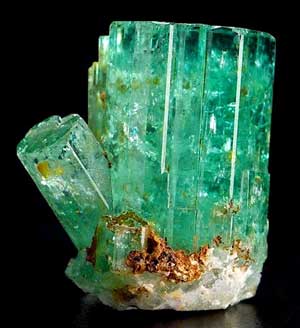
Exceptional Minerals specimen and photo.
News From Mount Antero
The granite pegmatites of Mount Antero, Chaffee County, Colorado have been yielding North America’s finest aquamarine beryl crystals since the 1880s, and collecting on the 14,276-foot mountain—known as America’s highest mineral locality—is still going strong. There are many great stories of great discoveries (some of the best are told by Mark Jacobsen and Bryan K. Lees in the Mount Antero chapter of American Mineral Treasures, 2008), so it’s not surprising that legions of diggers brave the switchback dirt road up the mountain each summer, either to dig on the talus slopes in search of the contents of collapsed crystal pockets, or actually to blast into the pegmatite bodies where they are exposed.
Among the contemporary adventurers on Mount Antero are Coloradoans Brian Busse, his wife, and his five sons (aged 11 to 25), who for five years now have been working a claim which they have reverentially named the “Thank You Lord Aquamarine Mine.” Recently I got a call from Brian, who at the time was in Tucson, cleaning and sorting material from some of the family’s latest forays on the mountain. He wanted to let it be known that the Busse family will have an exhibit case of their Mount Antero discoveries at this fall’s Denver Show, and that they will be selling Mount Antero materials for the collector, gem and lapidary markets at the “Colorado Marketplace” during that same show. To judge from what Brian and two of his sons had to show me the other day here in Tucson, I think that you certainly should check them out if you’re going to Denver in September 2010.
The Thank You Lord Aquamarine Mine exploits a pegmatite in situ, with fresh material coming out from under a mini-glacier of ice whose thickness varies, of course, with the season. The “raw” specimens I saw on the Busses’ table in Tucson are cabinet-size masses of jumbled aquamarine crystals cemented by brown, decomposed feldspar, with quartz; the crystals of pale blue and greenish blue aquamarine are non-terminated and for the most part not gemmy, but they reach 12 cm long. Further, there are loose, thick crystals of aquamarine to jumbo sizes, some showing hexagonal rings, concentric around the c axis, marked by crisp brown lines of iron oxides—this was the first time I’d seen such nested “growth rings” on beryl crystals. Scattered around the table, too, were loose, chalky white feldspar crystals to 6 cm and many gemmy, dark smoky quartz crystals, these reaching 8 cm; and there were two fine thumbnails of phenakite, each with a sharp, 1.5-cm crystal perched lightly on a white feldspar shard.
In compartments of jewelers’ trays there were many limpid loose crystals of aquamarine, some etched, most non-terminated…but also there were a few sharp, bright, pale blue, wholly gemmy, singly terminated crystals to 3.5 cm long. And, some of the Busses being lapidaries, there were several trays of aquamarine cabochons which showed a surprising chatoyancy on their surfaces, and could make beautiful brooches or pendants.
Brian is expecting great things from this coming summer’s work on the mountain. See him in Denver: he deserves every encouragement for his hard work and for his success so far, not to mention for having kept five boys fully committed to crystal-digging for years on end, thus doing his bit to brighten the world of the future for crystal diggers in general, everywhere.
Houston and San Francisco Shows
For the past couple of years, Dave Waisman has been bringing mineral shows to major cities that have so far gone without them, but where there are many serious mineral collectors around who may need something to tide them over between Tucson and Denver. Accordingly, the second Houston Fine Mineral Show is happening on Friday, April 30 through Sunday May 2 at the Embassy Suites Hotel, 2911 Sage Rd. (in the Galleria area), Houston: see my report on the first edition of this show in the July-August 2009 issue. Also, Dave’s first San Francisco show will be attracting visitors (and I’ll be on hand to report on it) during the period July 9-11. You’ll soon see a full-page ad for this one in the Mineralogical Record, and more information is available on Dave’s site: www.FineMineralShow.com.
So long for now from the (too rapidly warming) Sonoran desert.
For questions about this column, please email Tom Moore.
